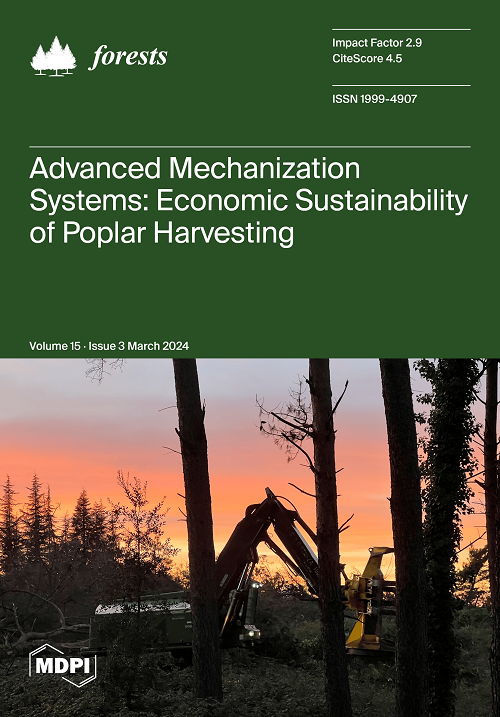Physiological Responses Revealed Static Magnetic Fields Potentially Improving the Tolerance of Poplar Seedlings to Salt Stress
IF 2.5
2区 农林科学
Q1 FORESTRY
引用次数: 0
Abstract
Magnetic fields play an important role in regulating plant growth and development, especially in improving plant stress tolerance. However, the physiological mechanism underlying the magnetic effects is still unclear. Here, we examined changes in reactive oxygen species (ROS) levels and ion flux in poplar (Populus × deltoides ‘Lulin-2’) seedling roots under salt stress in a static magnetic field (SMF). SMF treatment significantly increased seedling growth and mitigated the effects of salt stress on root growth. Furthermore, SMF treatment activated ROS and calcium signals in poplar roots. Relative to the SMF treatment group, control plants had significantly higher levels of cytoplasmic free Ca2+ ([Ca2+]cyt) and ROS following exposure to high salt concentrations. Under salt conditions, SMF treatment reduced increases in Na+ concentrations and maintained stable K+ and Ca2+ concentrations and K+/Na+ and Ca2+/Na+ ratios. NMT analysis suggests that SMF treatment may drive cation effluxes in poplar seedling roots. Susceptibility tests of Na+-transport inhibitors indicated that SMF treatment contributed to Na+ repulsion and H+ uptake under salt stress. Moreover, SMF exposure allowed roots to retain the ability to reduce salt-induced K+ and Ca2+ root effluxes, and qRT-PCR results demonstrate that SMF treatment can increase the expression of stress-responsive genes such as PtrRBOHF, PtrNHX1 and PtrHA5 in poplar seedlings. Therefore, we conclude that treating poplar seedlings with SMF can help them establish a stable tolerance to salt stress by regulating ROS, [Ca2+]cyt, and their regulatory networks. This study examined the physiological responses of poplar to SMF exposure under salt stress, providing insights into plant magnetobiological effects.生理反应揭示静态磁场可能提高杨树幼苗对盐胁迫的耐受性
磁场在调节植物生长和发育,尤其是提高植物抗逆性方面发挥着重要作用。然而,磁效应的生理机制尚不清楚。在这里,我们研究了静态磁场(SMF)中盐胁迫下杨树(Populus × deltoides 'Lulin-2')幼苗根部活性氧(ROS)水平和离子通量的变化。静磁场处理能明显提高幼苗的生长速度,减轻盐胁迫对根系生长的影响。此外,SMF 处理激活了杨树根部的 ROS 和钙信号。与 SMF 处理组相比,对照组植物在暴露于高浓度盐后,细胞质游离 Ca2+ ([Ca2+]cyt)和 ROS 水平明显更高。在盐条件下,SMF 处理降低了 Na+ 浓度的增加,保持了 K+ 和 Ca2+ 浓度以及 K+/Na+ 和 Ca2+/Na+ 比率的稳定。NMT分析表明,SMF处理可能会驱动杨树幼苗根部的阳离子外流。Na+转运抑制剂的敏感性测试表明,SMF处理有助于盐胁迫下的Na+排斥和H+吸收。此外,SMF 暴露使根系保留了减少盐诱导的 K+ 和 Ca2+ 根外流的能力,qRT-PCR 结果表明,SMF 处理可增加杨树幼苗中 PtrRBOHF、PtrNHX1 和 PtrHA5 等应激反应基因的表达。因此,我们得出结论:用 SMF 处理杨树幼苗可以通过调节 ROS、[Ca2+]cyt 及其调控网络帮助它们建立对盐胁迫的稳定耐受性。本研究考察了杨树在盐胁迫下暴露于 SMF 的生理反应,为植物磁生物学效应提供了见解。
本文章由计算机程序翻译,如有差异,请以英文原文为准。
求助全文
约1分钟内获得全文
求助全文
来源期刊

Forests
FORESTRY-
CiteScore
4.40
自引率
17.20%
发文量
1823
审稿时长
19.02 days
期刊介绍:
Forests (ISSN 1999-4907) is an international and cross-disciplinary scholarly journal of forestry and forest ecology. It publishes research papers, short communications and review papers. There is no restriction on the length of the papers. Our aim is to encourage scientists to publish their experimental and theoretical research in as much detail as possible. Full experimental and/or methodical details must be provided for research articles.
 求助内容:
求助内容: 应助结果提醒方式:
应助结果提醒方式:


